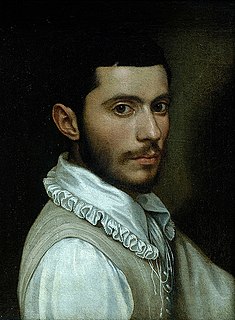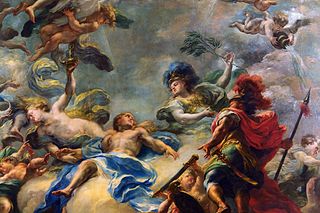Related Research Articles

Luca Giordano was an Italian late-Baroque painter and printmaker in etching. Fluent and decorative, he worked successfully in Naples and Rome, Florence, and Venice, before spending a decade in Spain.

Belisario Corenzio was a Greek-Italian painter, active in Venice and Naples. He is one of few Greek painters that did not belong to the Cretan Renaissance like his contemporaries of the time. He escaped the maniera greca completely. He adopted the Venetian style. Other similar Greek painters were Marco Basaiti, Ioannis Permeniates, Antonio Vassilacchi and El Greco. He was sometimes referred to as Il Greco. His teacher was prominent Venetian painter Tintoretto. In 1590, at age 32 Corenzio settled in Naples. Corenzio was influenced by Cavalier d'Arpino. He continued to flourish in the region. His apprentices included: Luigi Rodriguez, Andrea di Leone, Onofrio De Lione and Massimo Stanzione. Corenzio painted many frescos that survived today. Some of his works are in the Church of San Severino and Certosa di San Martino. His style resembles Caravaggio. An Italian legend in Naples exists involving Corenzio, Spanish painter Jusepe de Ribera, and Battistello Caracciolo. They were referred to as the Cabal of Naples. The three painters were rumored to have poisoned their competition for painting contracts. The rumors lack documented evidence. The three painters were very popular in Naples. Corenzio frescoed the Crypt that holds the remains of Matthew the Apostle at Salerno Cathedral and it depicts scenes from the Gospel of Matthew. Corenzio was one of the most celebrated fresco painters in Naples during his time. His drawings can be found all over the world namely at the Metropolitan Museum, Museo di Capodimonte and Louvre.

Jusepe de Ribera was a Spanish Valencian Tenebrist painter and printmaker, also known as José de Ribera and Josep de Ribera. He also was called Lo Spagnoletto by his contemporaries and early writers. Ribera was a leading painter of the Spanish school, although his mature work was all done in Italy.

Giovanni Battista Caracciolo (1578–1635) was an Italian artist and important Neapolitan follower of Caravaggio. He was a member of the murderous Cabal of Naples, with Belisario Corenzio and Giambattista Caracciolo, who were rumoured to have poisoned and disappeared their competition for painting contracts.

Scipione Pulzone, also known as Il Gaetano, was a Neapolitan painter of the late Italian Renaissance. His work differs in several respects from the Mannerist style predominant at the time. He was active mainly in Rome, but also worked in Naples and Florence. It is thought that he studied under Jacopino del Conte in Rome.

San Pietro Martire is a Roman Catholic church in Naples, Italy. It is located directly across from the principal building of the University of Naples on the main street, Corso Umberto corner with Via Porta di Massa, near the port area. In the piazza in front of the church is a statue of Ruggero Bonghi.

Andrea Vaccaro was an Italian painter of the Baroque period. Vaccaro was in his time one of the most successful painters in Naples, a city then under Spanish rule. Very successful and valued in his lifetime, Vaccaro and his workshop produced many religious works for local patrons as well as for export to Spanish religious orders and noble patrons. He was initially influenced by Caravaggio, in particular in his chiaroscuro and the naturalistic rendering of his figures.
Lazzaro Calvi (1512–1587) was an Italian painter of the late-Renaissance period. He was born in Genoa and trained with his father Agostino Calvi and Perin del Vaga. Older sources claim he lived till the improbable age of 105 years
Silvestro de Buoni was an Italian painter of the early-Renaissance period, specifically the Quattrocento in Naples. Also called Silvestro de Buono, son of Buono de' Buoni. He was the pupil of the painter Lo Zingaro and Donzelli. He is sometimes confused with Silvestro Morvillo. He painted an Assumption of the Virgin for San Pietro Martire of Naples.
Bernardo Tesauro (1440–1500) was an Italian painter of the Renaissance period. He was born in Naples. He was a relative of Filippo Tesauro. He was a pupil of Silvestre dei Buoni. He painted an Assumption of the Virgin for the church of San Giovanni Maggiore in Naples.
Agostino Beltrano was an Italian painter active in the Baroque period in his native city of Naples. He was a pupil of Massimo Stanzione, the uncle of his wife, and is known to have been active in 1646. He is said to have murdered his 36-year-old wife and painter, Aniella di Beltrano, in a fit of jealousy. He died in Naples.

Thomas Jones was a Welsh landscape painter. He was a pupil of Richard Wilson and was best known in his lifetime as a painter of Welsh and Italian landscapes in the style of his master. However, Jones's reputation grew in the 20th century when more unconventional works by him, not originally intended for exhibition, came to light. Most notable among these is a series of views of Naples which he painted from 1782 to 1783. By breaking with the conventions of classical landscape painting in favour of direct observation, they look forward to the work of Camille Corot and the Barbizon School in the 19th century. His autobiography, Memoirs of Thomas Jones of Penkerrig, went unpublished until 1951 but is now recognised as an important source of information on the 18th-century art world.
Pompeo Landulfo was an Italian painter active mainly in Naples. He was born in Maddaloni near Caserta, Italy.

Abate Andrea Belvedere was an Italian painter of the Baroque period.

Giacomo del Pò, also spelled del Po, was an Italian painter of the Baroque. He was born in Palermo, the son of Pietro del Pò who was also his teacher.

Wenceslas Cobergher, sometimes called Wenzel Coebergher, was a Flemish Renaissance architect, engineer, painter, antiquarian, numismatist and economist. Faded somewhat into the background as a painter, he is chiefly remembered today as the man responsible for the draining of the Moëres on the Franco-Belgian border. He is also one of the fathers of the Flemish Baroque style of architecture in the Southern Netherlands.

Matthias Stom or Matthias Stomer was a Dutch, or possibly Flemish, painter who is only known for the works he produced during his residence in Italy. He was influenced by the work of non-Italian followers of Caravaggio in Italy, in particular his Dutch followers often referred to as the Utrecht Caravaggists, as well as by Jusepe de Ribera and Peter Paul Rubens. He did not share the other Northern Caravaggisti's preference for humorous, and sometimes scabrous, genre scenes and elaborate decorative allegories but favored stories from the bible instead. He worked in various locations in Italy where he enjoyed the patronage of religious institutions as well as prominent members of the nobility.
Giovanni Angelo Criscuolo was an Italian painter active mainly in Naples.
Tommaso degli Stefani (1231–1310) was an Italian artist, working in Naples.

Francesco Paolo Michetti was an Italian painter known especially for his genre works.
References
 This article incorporates text from a publication now in the public domain : Bryan, Michael (1886). "De Buoni, Buono". In Graves, Robert Edmund (ed.). Bryan's Dictionary of Painters and Engravers (A–K). Vol. I (3rd ed.). London: George Bell & Sons.
This article incorporates text from a publication now in the public domain : Bryan, Michael (1886). "De Buoni, Buono". In Graves, Robert Edmund (ed.). Bryan's Dictionary of Painters and Engravers (A–K). Vol. I (3rd ed.). London: George Bell & Sons.